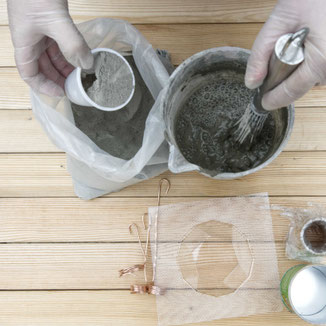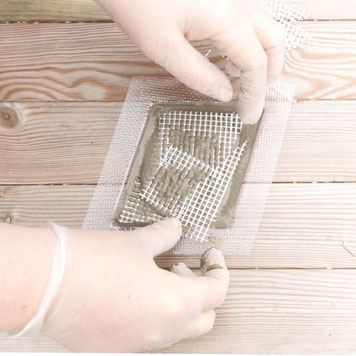Concrete is a wonderful versatile material to work with. What concrete is, how to get started to work with it and what tools to use, here are the basic tips and tricks as well as answers to your most asked questions since I started my DIY's.
What is concrete?
Even though cement and concrete are often used to describe the other, or as equal, they are not the same. Concrete was first used thousand of years ago in roman structures. However, cement and concrete are not one and the same but rather that cement forms part of concrete. The term ‘concrete’ is used for the material that is created from a mix of aggregates, mostly stones or sand with cement that is activated with water. Once this mixture reacts, which is also called the curing process, a bit of heat is generated. Once this is done it cools back down and the concrete is almost as hard as stone.
Which concrete mix to use for which crafting project?
Mostly lime-based cement which is also know as Portland cement or all purpose cement. It is most often used with gravel or crushed stones, glass shards to craft sidewalks, stepping stones, maybe chairs or tables, large planter bowls and so on. This is a mix for larger crafting projects.
For smaller projects a finer mix should be chosen. You could still start with an all purpose cement and just use finer aggregates like sand, if you use - like I do - coloured sands it will also change the final colour of your concrete. You could also use fabric or styrofoam balls or used shredded plastic. I have seen rubbish shredded and used as aggregate to create tiles at the Venice Biennale for example. Just keep in mind the smaller the object you are crafting, the finer the aggregate should be.
Anyhow, if the objects are small a quick mix, which usually has all what's needed combined already, is often a good to go solution. You simply add water and you are good to go for small projects like the candle holder or Air Plant stands.
Indeed you should protect yourself!
Concrete, can be a messy material and it should not be on your skin which is why I recommend some simple gloves. Of course it is best to protect your eyes and as the dust can be harmful to your lungs a mask as well as glasses for eyes are advisable.

Is a workshop required? Can it work without a mess?
No, a workshop is not needed but some tools and you might want to cover the area you are planning to work in. Maybe similar to the way you would do if it were a paint job. Otherwise outside is always a good idea and you simply use a level area to have the concrete mix cure.
Yes, one can work almost without a mess and very little waste if you use fairly flexible mixing tools like plastic bowls and spoons. Once the concrete hardened you should be able to bend it a bit and the dry concrete comes off all the tools you have used. And even those little bits can be used as the base layer in a planter or you keep them for your next project where you wish to add texture to your mix.
A little tip - at the beginning of your concrete crafting journey it might happen that you have too much concrete mix prepared and it would be wasted. To prevent this I recommend to have a spare mould or a plastic cup around. You can fill this with the left overs - it's always good to make a pavement stone, sculpture or paperweight but with some experience this won't happen that much ;)
What makes concrete stronger?
There is a wide range of reinforcements available, from recycled sticks to new rebars and metals, glass as well as plastic fibre, cotton, hemp, coconut fibre and many more. It purely depends on the project, of course if the concrete requires a certain strength you will have to relay on tests but all of the above can be used.
The coaster DIY's, like the hexagon or the rhombus, use the fibre matting but you could also use loose fibres.
Is concrete sustainable?
Cement in itself is not sustainable. However, there are options on recycling concrete as well as eco concrete is being talked about.

Nevertheless, I think it still is a good material which could help combine recycled materials or materials which would usually be disregarded as waste to build other things or even houses. Haha, indeed houses of course, concrete is to me an artistic material but yes of course you can build a shelter. But keep in mind it is not just the material but also how it is used which will make or break its sustainability. For example a concrete pavement or driveway is very harmful to our environment for all sorts of reasons but if you use it in a sculpture, combine it with recycled materials or even use eco concrete it will be just fabulous. One way of using cement and doing something good for nature is by crafting Hypertufa vessel for your garden but I think I will be writing more on this in a separate post, what do you think?
Feel free to leave a comment or email as always with more or other questions, see you soon and happy crafting, Antje
You might also like ...









Write a comment
Johnny McCarron (Thursday, 26 September 2019 03:28)
Thank you so much for your tips on working with concrete. We're thinking of laying down a walkway from our front door to the driveway. We'll probably end up using something like ready-mix concrete.
Elina Brooks (Wednesday, 19 April 2023 07:22)
I wanted to improve the way my backyard garden looked, so I'm considering using concrete for the hardscape features I was planning to add. Thank you for letting us know that concrete can become stronger by using various reinforcements like rebars and metals, and conducting tests if the concrete requires a certain strength. I'll take note of this while I look for a residential concrete contractor to hire for the project soon.